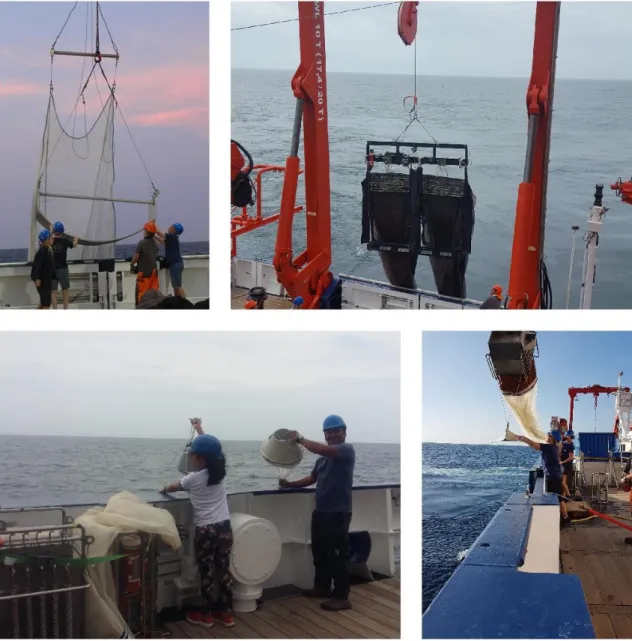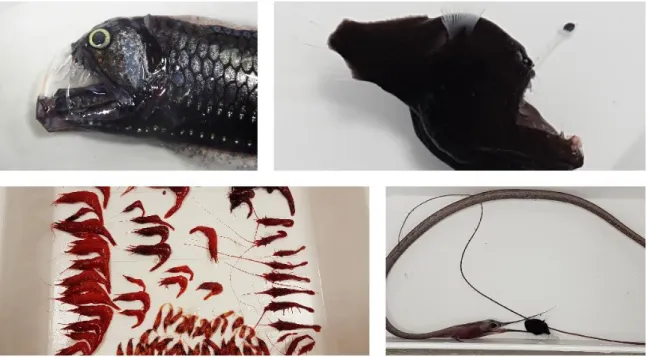20.01.2019 15°12‘S 076°30‘W 65 nautical miles off the Peruvian coast MSM80 CUSCO
Fifth weekly report for the period from 14.01. until 20.01.2019
During the previous weeks, we studied the large-scale pattern of upwelling in the Humboldt Current along the Peruvian coastline. In order to do so, we sampled a station grid determined beforehand.
Thus, cruise and working schedules could be pre-planned several days in advance.
Since the last few days, this has changed. We now want to understand small- or meso-scale processes and differences in water mass distribution and upwelling intensity. How and why do hydrographic parameters, such as temperature and salinity, as well as plankton biomass and composition change over only a few miles? What are the reasons for such a high spatial variability over short distances?
For that purpose, we deployed the ScanFish along three sections, which are separated by only a few miles in geographic latitude at 15°12’S, 15°18’S and 15°25’S and extend from the coast far into the open ocean. The ScanFish is a device, which measures salinity, temperature and other parameters in high spatial resolution, while being towed at a speed of six knots behind the vessel and permanently undulating between the sea surface and greater depths.
The spatial analysis of the data revealed certain areas with colder, less saline or warmer, saltier water, respectively. There are also differences in biological parameters. Almost 70 miles off the coast, we found a spot with a typical coastal zooplankton community, dominated by small copepod species. At another location, also far away from the coast, the water was not clear and blue as would be
expected for the open South Pacific, but murky green-brown like the Rivers Weser or Rhein. Water samples showed that the dark greenish colour was caused by an intense algal bloom of
dinoflagellates and small diatoms, which one would usually expect closer to shore in a coastal upwelling region, but not 65 miles offshore above 5.000 m water depth.
During the upcoming days, we will intensively sample these small-scale structures. There are
indications that they might represent eddies, which separate different water bodies and can relocate them over longer distances quite rapidly so that coastal plankton communities may be advected far offshore. This could also be an important mechanism for the export of organic matter from the coastal upwelling system into the adjacent open ocean. At the same time, this would substantially increase the area affected and “fertilised” by the upwelling from a narrow strip of shallow water on the shelf to a larger region including deep oceanic waters. Such a seaward extension of the upwelling region could be one of the reasons for the high productivity of the coastal upwelling system off Peru.
For the crew of R/V Maria S. Merian and the scientists on board the modified sampling strategy comprises a certain challenge. Cruise schedules and work plans can only be prepared on short notice, as the newest measurements will always have to be taken into account.
In this weekly report, the biologists from the University of Hamburg will introduce their work. The team from Hamburg consists of five scientists, who – in the framework of the CUSCO project and the research cruise MSM 80 – focus on fish larvae and gelatinous zooplankton (i.a. jellyfish and salps).
For that purpose, particularly large plankton nets must be deployed. The Isaacs-Kidd Midwater Trawl (IKMT) has a mouth opening of 10 square metres, while the 1-square-metre-double-MOCNESS (Multiple Opening/Closing Net and Environmental Sensing System) includes 18 separate nets attached to one common frame. The nets can be opened sequentially one after the other or in parallel two nets at the same time, providing a high vertical and/or spatial resolution for zooplankton
sampling. The University of Hamburg is the only institution in Germany operating such MOCNESS systems.
In the meantime, the biologists from Hamburg have deployed all of their nets. Small Apstein nets with mesh sizes of 55 and 100 µm were used along the section off Callao to sample phyto- and microzooplankton for comparison to the CUSCO mesocosm experiment in Callao next year. So far, a total of 70 towed Multinet deployments provided quantitative samples for later analysis of
zooplankton distribution in the Humboldt Current off Peru in the home lab. Another part of the samples was analysed immediately after the catch here on board and deep-frozen at -80°C to be used for biochemical analyses. Major focus is on gelatinous organisms and fish larvae of the Peruvian anchovy Engraulis ringens (anchoveta) and the mesopelagic fishes Vinciguerria lucetia and
Diogenichthys laternatus. The Multinet is equipped with a CTD and it is lowered to 100 m depth in order to target specifically the thermocline. The IKMT also catches gelatinous zooplankton and fish larvae. It is one of only few net-types, which allow careful capture and retrieval of even large jellyfish medusae and siphonophores in undamaged condition. At deeper stations, we often find fantastic deep-sea creatures in our nets, such as snipe eels, pelican and anglerfishes or diverse big, scarlet-red crustaceans. At the deepest stations of the transects, the scientists from Hamburg deploy the MOCNESS. Due to its size and the huge number of separate nets, it provides excellent data on zooplankton distribution and composition in high resolution, if it functions properly. However, the MOCNESS is also a difficult and sensitive piece of gear. Already several times, we had to cope with water pressing into the electronic unit. Only the skilful and tireless support by the scientific-technical service (WTD), the ship’s engineers, technicians and fitter keep the MOCNESS “alive” and ensure its deployment.
Two colleagues from IMARPE, Elda and Jonathan, support the team from Hamburg. Their knowledge about the native fauna of Peru allows the identification of many taxonomic groups down to species level, and they help with the deployment of nets and processing of samples by day and night.
Yesterday, the last week in the study area has started. We prepare for a work-intensive final spurt of this very successful cruise and wish you all
Best Regards on behalf of all cruise participants,
Bettina Martin (for the team from Hamburg) and Holger Auel
Fig. 1: Various plankton nets of the University of Hamburg in action: Isaacs-Kidd Midwater Trawl (IKMT, upper left), 1-square-metre-double-MOCNESS (upper right), Apstein net (lower left), towed Multinet (lower right) (Fotos: G. Wolters, A. Paul, B. Martin, A. Welker)
Fig. 2: IKMT catch from max. 1.000 m depth: Viper fish (upper left), black deep-sea angler fish (upper right), red deep-sea shrimps (lower left), snipe eel (lower right) (Fotos: S. Janßen)

